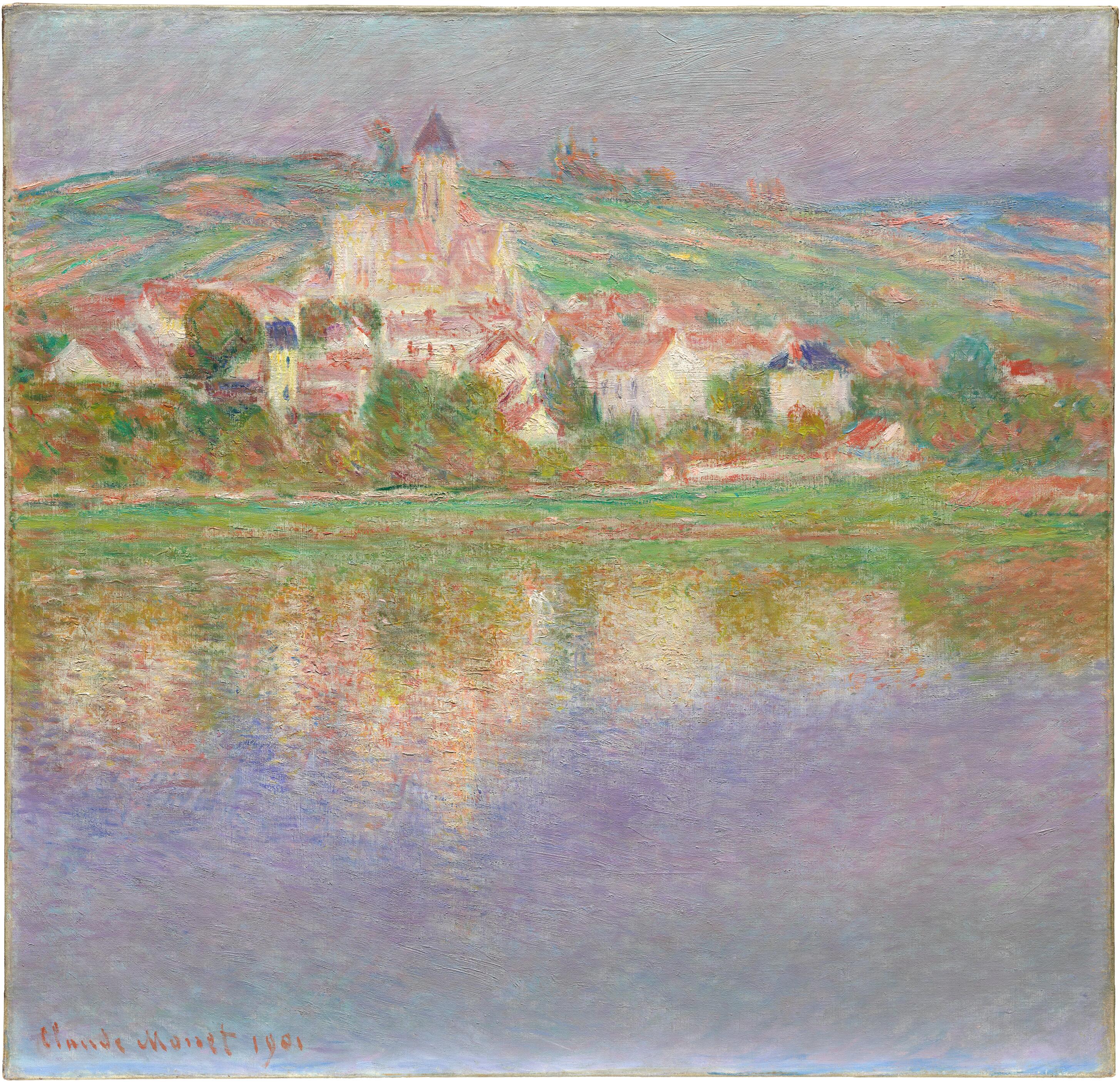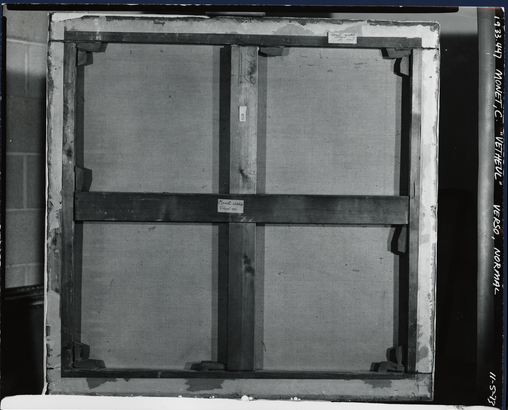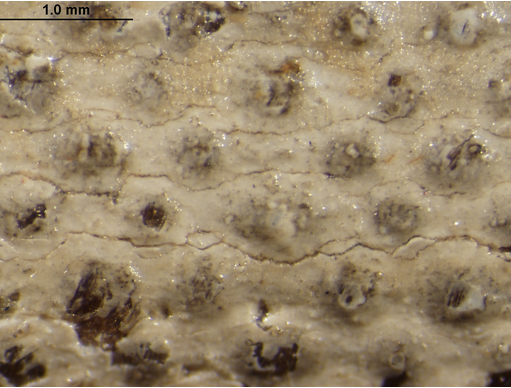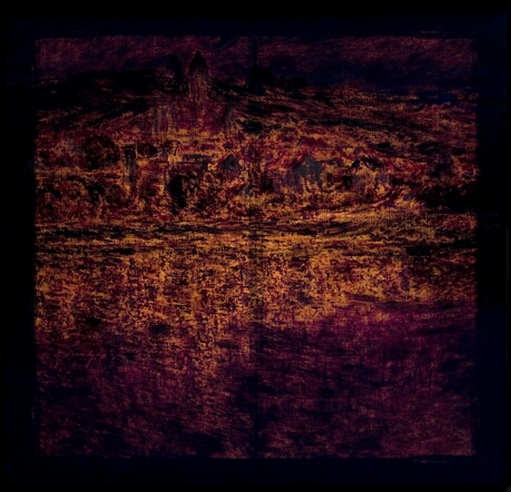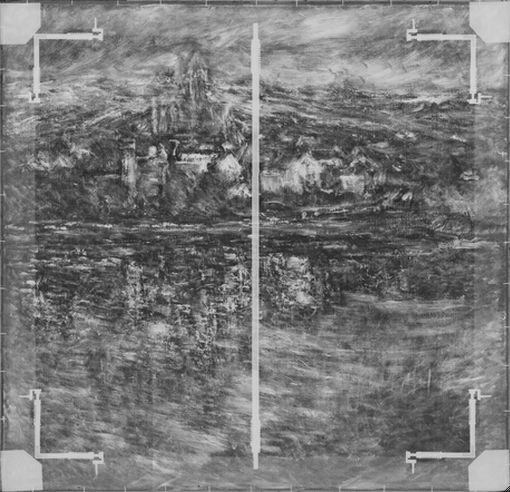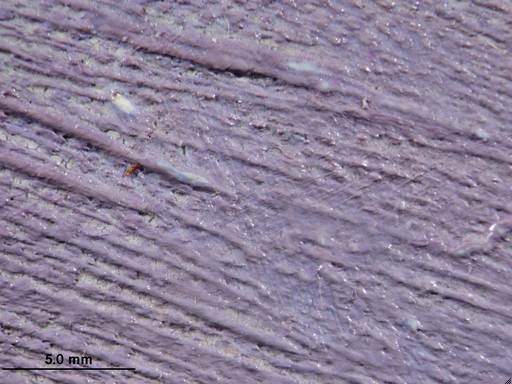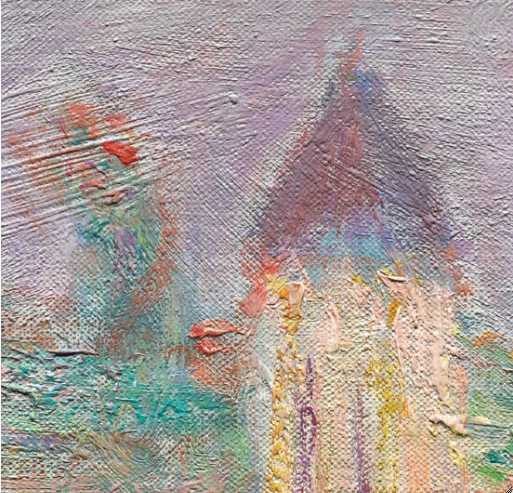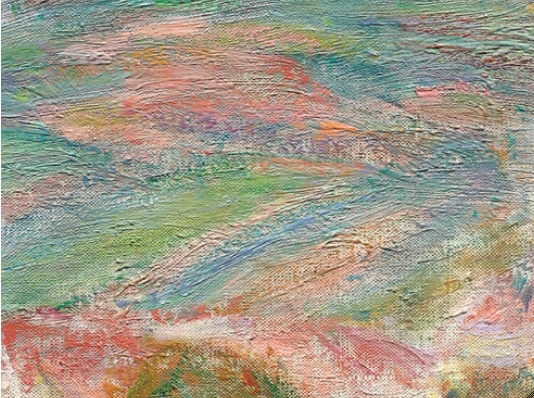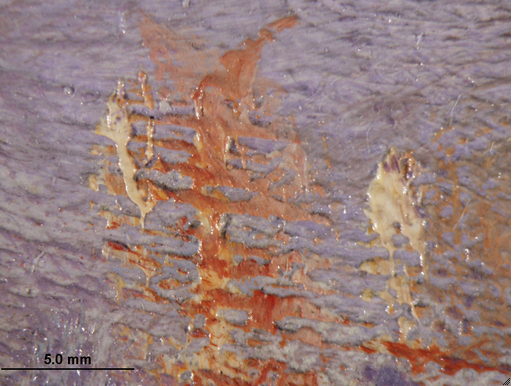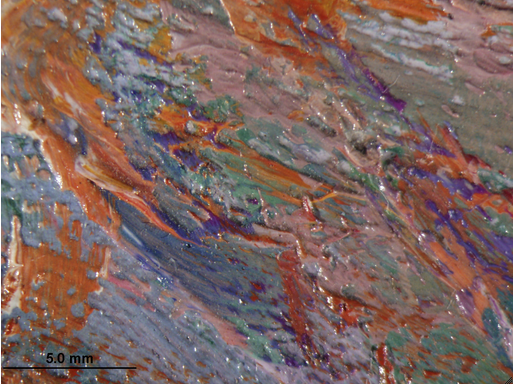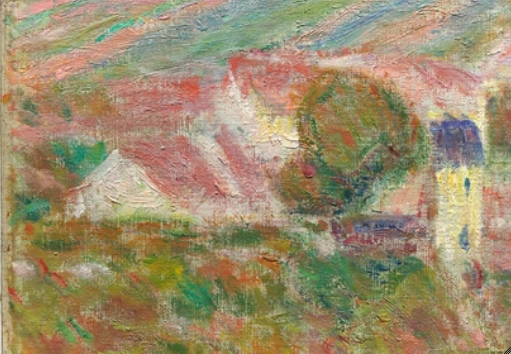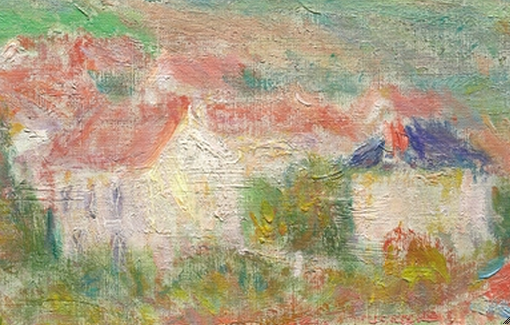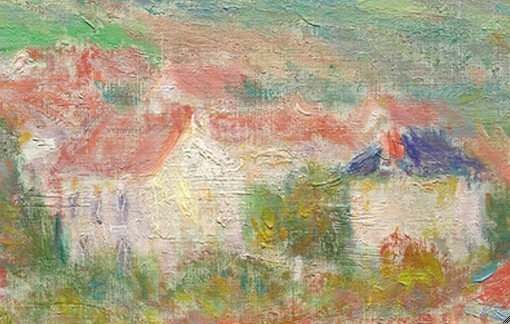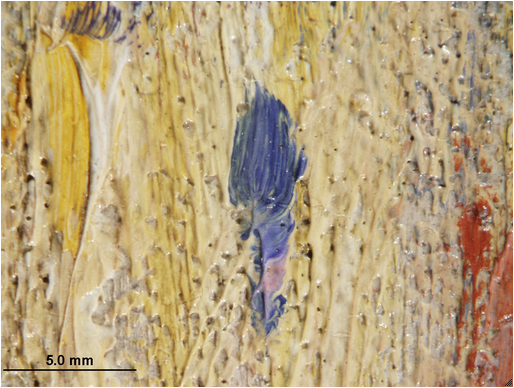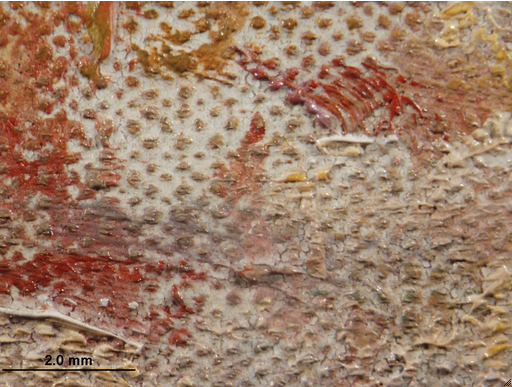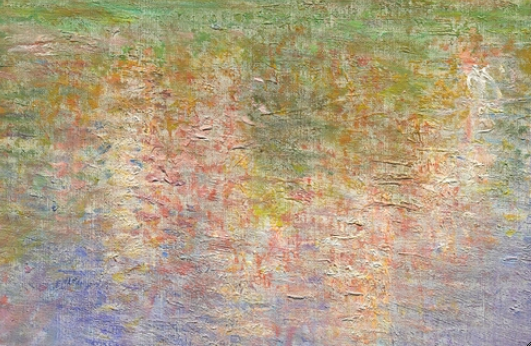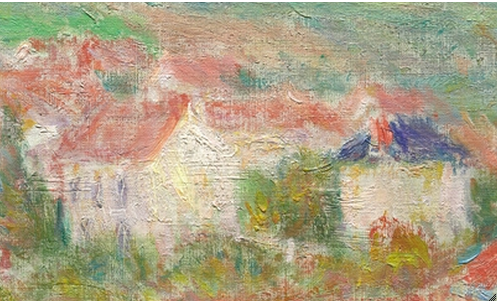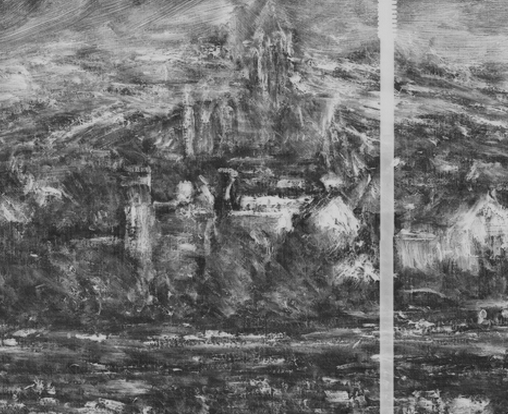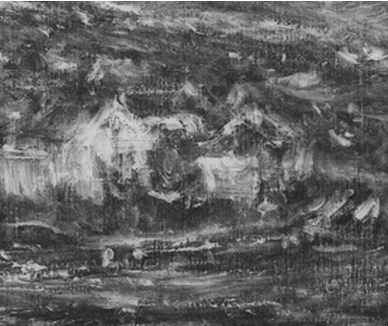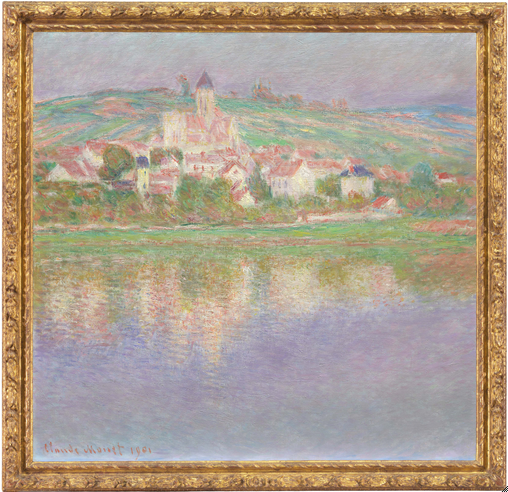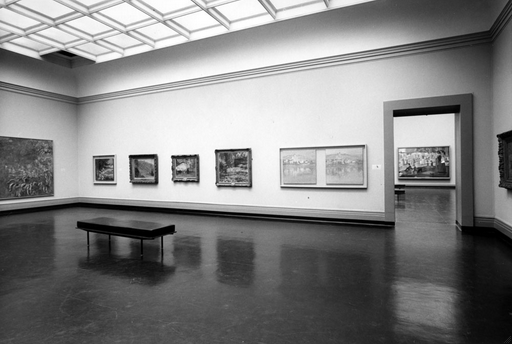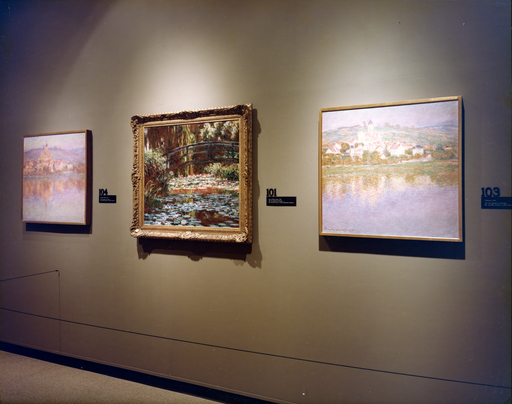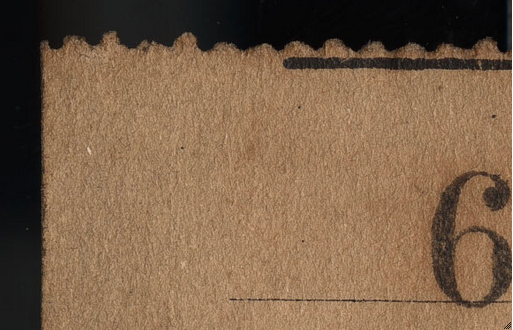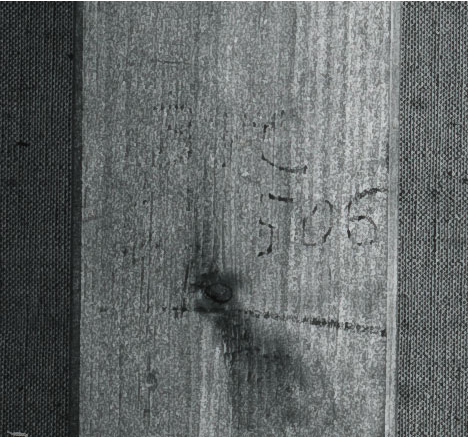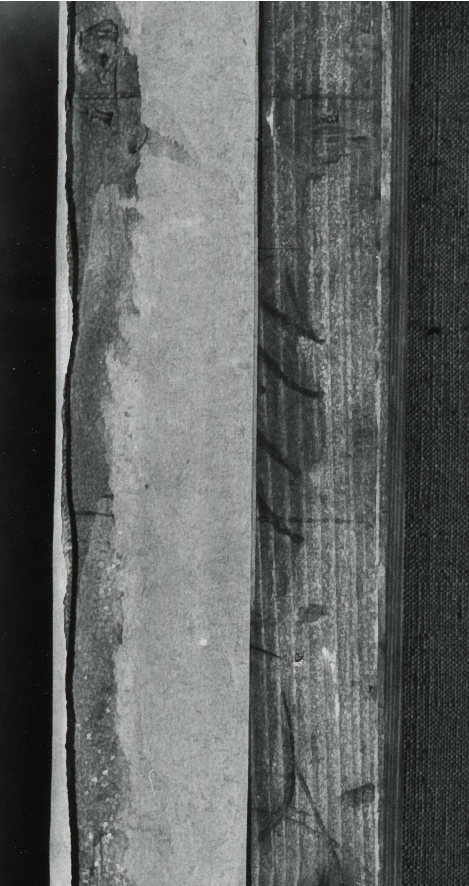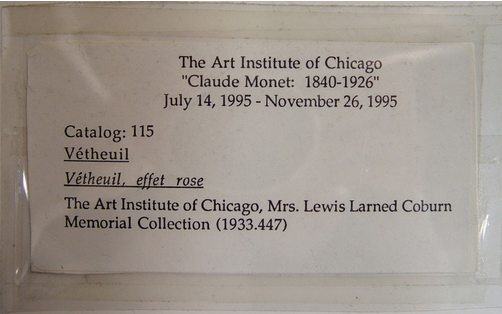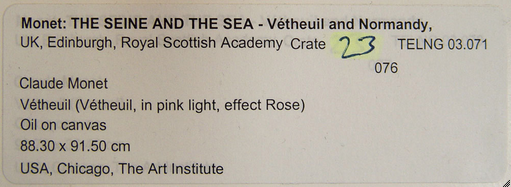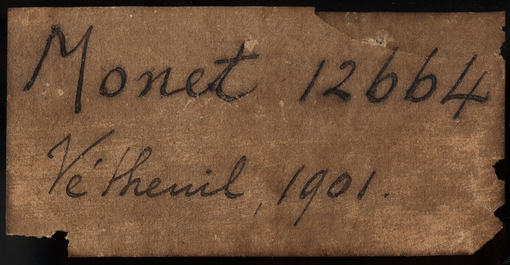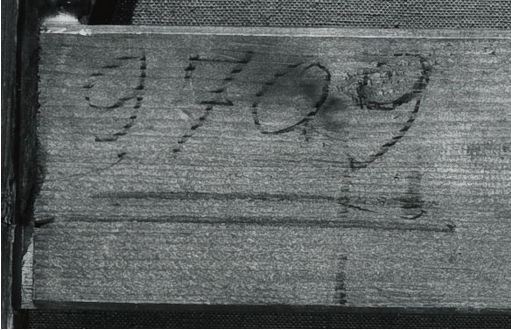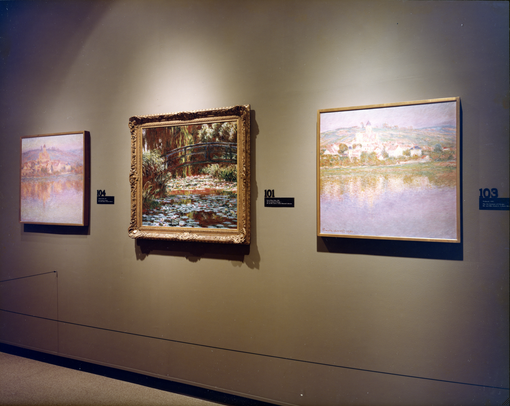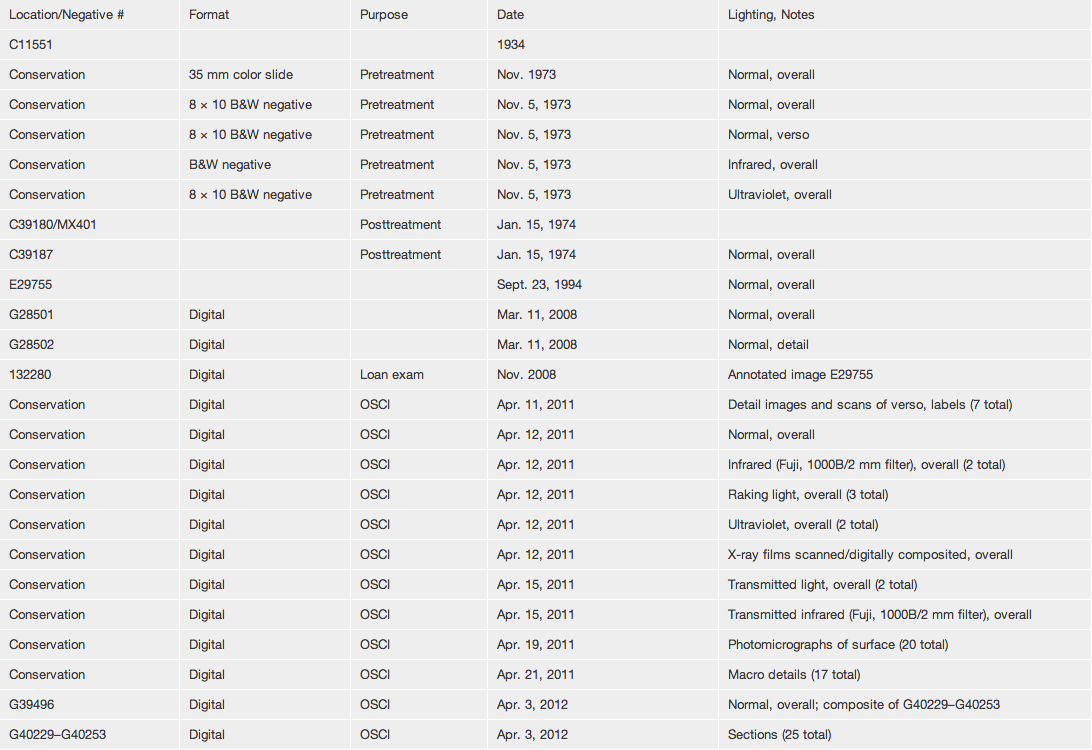Technical Report
Technical Summary
Claude Monet’s Vétheuil was executed on a pre-primed, non-standard-size linen canvas. A warp-thread match was detected with Waterloo Bridge, Gray Weather (1900; 1984.1173 [W1557]) (cat. 38), suggesting that the fabric for these paintings came from the same bolt of material. The ground consists of a single, off-white layer. A light-toned, brushmarked underpainting layer was broadly applied in the sky and the foreground area of the water. The central area of the painting (the landscape, the village, and the reflections), on the other hand, were painted directly on top of the ground layer, which remains exposed in small areas through breaks in the open network of brushstrokes. For the most part, the paint was relatively thinly applied, often lightly dragged across the surface in strokes that accentuate the texture of the underlying canvas weave. Slightly thicker, brushmarked strokes define the features of the hillside and daubs of impasto were used for the light-colored walls of the buildings and their reflections, creating a varied surface texture. The work includes both wet-on-wet and wet-over-dry paint applications, applied in discrete touches of color with very little blending on the canvas. A few minor changes were made to some of the buildings in the foreground of the village, which seem to be related to slight shifts in position or changes in size.
Multilayer Interactive Image Viewer
The multilayer interactive image viewer is designed to facilitate the viewer’s exploration and comparison of the technical images (fig. 42.1).
Signature
Signed and dated: Claude Monet 1901 (lower left corner, in orange-red paint) (fig. 42.2). Traces of similar paint to the left of the C suggest that the signature was initially started in a slightly lower position and closer to the left edge. It also appears that the final C was started with a paler orange paint, then gone over with the deeper orange that was used for the rest of the signature and date (fig. 42.3). The underlying paint layers were dry when the painting was signed and dated.
Structure and Technique
Support
Canvas
Flax (commonly known as linen).
Standard format
The original dimensions were approximately 89 × 92 cm. This slightly wider than square format is not a standard size; both dimensions, however, correspond to standard stretcher-bar lengths.
Weave
Plain weave. Average thread count (standard deviation): 16.8V (0.7) × 19.9H (0.6) threads/cm; the horizontal threads were determined to correspond to the warp and the vertical threads to the weft. A warp-thread match was found with Waterloo Bridge, Gray Weather (1900; 1984.1173 [W1557]) (cat. 38).
Canvas characteristics
There is mild, fairly even cusping along all four edges. The cusping pattern appears to correspond to the placement of the original tacks.
Stretching
Current stretching: Dates to 1973–74 conservation treatment (see Conservation History); copper tacks spaced 7–10 cm apart.
Original stretching: Tack holes spaced 5–7 cm apart.
Stretcher/strainer
Current stretcher: ICA spring stretcher. Depth: 2.7 cm.
Original stretcher: The pre-1973/74-treatment stretcher may have been the original stretcher. An undated report in the conservation file describes the previous stretcher as a Buck type 2, six-membered, including horizontal and vertical crossbars, with keyable mortise and tenon joints and beveled at the back. The report gives the following dimensions: overall, 89.5 × 93 cm; outside depth, 1.7 cm; width, 6.5 cm; inside depth, 1.6 cm; distance from canvas position, 0.5 cm; length of mortise, 6.5 cm (fig. 42.4).
Manufacturer’s/supplier’s marks
None observed in current examination or documented in previous examinations.
Preparatory Layers
Sizing
Not determined (probably glue).
Ground application/texture
The ground layer extends to the edges of all four tacking margins, indicating that the canvas was cut from a larger piece of primed fabric, which was probably commercially prepared. Cross-sectional analysis indicates that the ground consists of a single layer that ranges from approximately 30 to 100 µm in thickness (fig. 42.5).
Color
The ground is off-white, with some dark and possibly red or brown particles visible under magnification (fig. 42.6).
Materials/composition
Analysis indicates that the ground contains lead white and calcium carbonate (chalk) with traces of iron oxide, silica, and silicates. Binder: oil (estimated).
Compositional Planning/Underdrawing/Painted Sketch
Extent/character
No underdrawing was observed with infrared reflectography (IRR) or microscopic examination.
Paint Layer
Application/technique and artist’s revisions
The village, landscape, and reflections in the water were all painted directly on top of the ground, whereas a relatively thick, textured underpainting was applied in the area of the sky and the foreground water. This selectively applied underlayer appears light in color and mostly covers the ground. It is evident when the work is viewed in transmitted light, which reveals that the painting is more translucent in the central area and more thickly built up in the top and bottom sections (fig. 42.7). The broadly applied, sweeping strokes of the underpainting in the sky and the water are visible in the X-ray (fig. 42.8), and the texture of these brushstrokes remains evident on the paint surface through the thinner, more flatly applied layers painted on top (fig. 42.9, fig. 42.10). Where the underpainting is visible through breaks and abrasion in the upper paint layers, it ranges in color from off-white to pale blue (fig. 42.11, fig. 42.12). The crisp ridges of the underlying brushstrokes were not disturbed by the subsequent buildup of paint, suggesting that there was some passage of time between the application of the underpainting and the upper paint layers (fig. 42.13).
The buildings and landscape, and their reflections, were built up using relatively open brushwork that leaves small patches of exposed ground visible throughout. The hillside consists of long, directional strokes of discrete color applied wet-on-wet with little blending of the strokes (fig. 42.14). In the execution of the hill, the earliest brushwork—likely associated with the initial lay-in—was lightly applied, often just hitting the peaks of the canvas weave; the surface was then built up using a more loaded brush that left thicker ridges of paint, as well as some final strokes, lightly applied, that skip across the surface revealing colors from underneath (fig. 42.15). Along the horizon, the artist moved back and forth between the sky and the landscape. For example, basic indications of the trees and church steeple were made over the textured underpainting of the sky; the purples and blues of the sky were then brought down around these features, with thicker strokes used to build up the foliage and the steeple, which was applied last, on top of the sky (fig. 42.16, fig. 42.17). Magnification reveals that some areas of foliage were composed from an array of superimposed strokes of discrete, often vivid, color (fig. 42.18). The general forms of the architecture were indicated with some very light, cursory brushwork. The landscape passes underneath the edges of the buildings, which indicates that it was built up, for the most part, before the buildings were developed (fig. 42.19, fig. 42.20). The buildings were often articulated using a combination of light, sketchy brushstrokes (such as the vermilion strokes used to delineate the rooftops) juxtaposed with thick, impasted, lead white–rich strokes (mainly for the light-colored walls) (fig. 42.21, fig. 42.22). Final details, such as the windows of the tall, thin, yellow building on the left side, were added wet-in-wet (fig. 42.23). The area occupied by the reflection was mapped out early on: both the underpainting and the blue and purple tones of the water stop roughly at the border between the water and the reflection. The ground layer remains visible through the open brushwork of the reflection (fig. 42.24). The forms reflected in the water were built up in a network of individual, short, mainly horizontal strokes (fig. 42.25).
Minor alterations were made to some of the buildings in the foreground of the village. On the right side, in the area of the blue-roofed house and the red-roofed one to the immediate left, there are two roughly square shapes and a strong horizontal stroke between them that are visible from beneath the surface (fig. 42.26). The thick, directional strokes of these underlying forms are visible in the X-ray (fig. 42.27), and their texture remains evident on the surface of the painting, particularly when viewed in raking light. The paint appears to be off-white in color. The underlying brushwork may constitute part of the early lay-in of the composition and thus indicate slight shifts in position or size between the initial planning of the houses and the painting of them. In the building on the far left, the X-ray seems to indicate the presence of a second pitched roof to the right of the one visible in the final composition. This was subsequently painted over (fig. 42.28).
The vertical canvas threads are sometimes more pronounced, probably the result of the sweeping horizontal strokes of the paint buildup, which emphasize the canvas texture in that direction. Areas of paint around the edges of the composition appear slightly flattened, as if the work was framed when the paint was still soft.
Painting tools
Brushes, including 0.5, 1.0, and 1.5 cm width, flat ferrule (based on width and shape of brushstrokes); a broader 2.0 cm wide brush was used for the underpainting in the sky and water. A few brush hairs are embedded in the paint layer.
Palette
Analysis indicates the presence of the following pigments: lead white, cadmium yellow, chrome yellow, vermilion, red lake, viridian, ultramarine blue, cobalt blue, and cobalt violet. UV fluorescence of some of the red strokes suggests the presence of red lake throughout the landscape.
Binding media
Oil (estimated).
Surface Finish
Varnish layer/media
The painting has a thin, even, synthetic varnish that was applied in 1974 (see Conservation History). The surface is relatively matte with subtle variations in surface sheen depending on the qualities of the underlying paint. The 1974 treatment report states that the painting previously had a discolored, yellowed, soft resin varnish; its origin is unknown.
Conservation History
In 1973–74, a discolored surface film was removed. The canvas was wax-resin lined and restretched on an ICA spring stretcher. A layer of polyvinyl acetate (PVA) AYAA was applied. Inpainting was carried out. A layer of methacrylate resin L-46 was applied, followed by a final layer of AYAA.
Condition Summary
Overall, the painting is in very good condition. It is wax-resin lined and the canvas is stretched taut on an ICA spring stretcher. There are no planar deformations. There is some wear around the edges of the canvas and a small hole at the upper right corner. There is a moderate amount of cracking and small losses in the ground layer on the tacking edges. There is some slight flattening of impastoed paint, which is probably related to the lining procedure. Minor retouching around the edges is related to abrasion and tiny losses, especially at the top and the lower left edges. There are wax-resin residues from the lining adhesive around the edges. There is a significant amount of starch-paste residue from the facing used during the lining process embedded in the recesses of the paint texture. This is mainly visible only under magnification, but has a subtle effect on the painting where it is more concentrated, scattering the light by causing those areas to look lighter. The synthetic varnish coating has an even, relatively matte surface that varies slightly according to the surface qualities of the underlying paint.
Kimberley Muir
Frame
Current frame (installed in 1991): The frame is not original to the painting. It is an American reproduction of a Louis XIII torus frame with carved centered flowers on a laurel-and-berry garland with acanthus-leaf miters, plain hollow, and carved ribbon ornament and cove at the sight (APF, Inc., New York, 1991). The frame is water gilded over brown bole on gesso. The hollow is burnished with selective burnishing on the carved ornament. The gold has been heavily rubbed overall and toned with thin oil paint washes, casein washes, and dark flecking. The carved basswood moldings are mitered and nailed. The molding, from perimeter to interior, is cushion-shaped dentil molding; torus with carved centered flowers on a laurel-and-berry garland with acanthus-leaf miters; fillet; hollow; fillet; torus with carved ribbon; and cove at the sight (fig. 42.29).
Previous frame (installed by 1975, removed 1991): The work was previously housed in an American, mid-twentieth-century, L-shaped narrow frame with a gilded face on a mahogany molding with exposed splines at the miters. The frame may be a design by James L. Speyer (fig. 42.30).
Previous frame: Sometime between 1956 and 1962 (based on an approximate date of an archival photograph (fig. 42.31), the work was mounted together with the Art Institute’s other version of Vétheuil in a painted shadow box. The paintings’ stretchers were mounted to the back panel of the frame with the edges of the canvas exposed. This frame was probably only utilized during this installation.
Kirk Vuillemot
Provenance
Sold by the artist to Boussod, Valadon & Cie., Paris, Feb. 15, 1902, for 8,000 francs.
Sold by Boussod, Valadon & Cie., Paris, to Rosenberg, Paris, May 26, 1903, for 10,000 francs.
Acquired by Alfred Savoir, Paris, by Mar. 22, 1922.
Sold at the Alfred Savoir, Paris, sale, Hôtel Drouot, Paris, Mar. 22, 1922, lot 16 (ill.), to Durand-Ruel, Paris, for 5,000 francs.
On deposit from Durand-Ruel, Paris, to Durand-Ruel, New York, by Apr. 22, 1922.
Sold by Durand-Ruel, Paris, to Durand-Ruel, New York, Apr. 22, 1922.
Sold by Durand-Ruel, New York, to Mrs. Lewis Larned (Annie Swan) Coburn, Chicago, Sept. 29, 1926, for $10,000.
Bequeathed by Mrs. Lewis Larned (Annie Swan) Coburn (died 1932), Chicago, to the Art Institute of Chicago, 1933.
Exhibition History
Paris, Bernheim-Jeune, Oeuvres récentes de Camille Pissarro et nouvelle série de Claude Monet, Feb. 20–28, 1902.
New York, Brooklyn Museum, Paintings by Contemporary English and French Painters, Nov. 29, 1922–Jan. 2, 1923, cat. 179, as Vetheuil, Messrs. Durand-Ruel.
Minneapolis Institute of Arts, An Exhibition of French Impressionist Paintings, Mar. 1–Apr. 30, 1923, cat. 22, as Vetheuil, 1901.
Providence, Rhode Island School of Design, May 22–Oct. 23, 1923, no cat.
New York, Union League Club, Paintings by Modern French Masters, Jan. 6–8, 1925, cat. 16, as Vetheuil.
Waterbury, Conn., Mattatuck Historical Society, Paintings by French Impressionists, Apr.–May 9, 1925, no cat.
Art Institute of Chicago, “A Century of Progress”: Loan Exhibition of Paintings and Sculpture for 1934, June 1–Oct. 31, 1934, cat. 222.
University of Chicago, Lexington Hall, Mar. 1–20, 1954, no cat.
University of Chicago, College of Humanities, Feb. 27–Mar. 16, 1956, no cat.
Art Institute of Chicago, The Paintings of Claude Monet, Apr. 1–June 15, 1957, no cat. no.
Art Institute of Chicago, Paintings by Monet, Mar. 15–May 11, 1975, cat. 103 (ill.). (fig. 42.32)
Edinburgh, Royal Scottish Academy, Monet: The Seine and the Sea, 1878–1883, Aug. 6–Oct. 26, 2003, cat. 76 (ill.).
Art Institute of Chicago, Claude Monet, 1840–1926, July 22–Nov. 26, 1995, cat. 115 (ill.).
Fort Worth, Tex., Kimbell Art Museum, The Impressionists: Master Paintings from the Art Institute of Chicago, June 29–Nov. 2, 2008, cat. 82 (ill.).
Selected References
Georges Riat, “Petites expositions: Expositions de Sisley et de MM. Monet et Camille Pissarro,” La chronique des arts et de la curiosité 8 (Feb. 22, 1902), p. 59.
Arsène Alexandre, “La vie artistique, II: Exposition Monet-Pissarro,” Le figaro, Feb. 27, 1902, p. 5.
Charles Saunier, “Gazette d’art: Monet, Pissarro, Sisley,” La revue blanche, Mar. 1, 1902, p. 385.
Edmond Pilon, “Carnet des oeuvres et des hommes, Plusieurs paysagistes” La plume, Mar. 15, 1902, pp. 411–13.
Tabarant, “La curiosité,” Bulletin de la vie artistique, Feb. 15, 1922, p. 89.
Le journal des arts, Mar. 18, 1922, p. 1.
Le journal des arts, Mar. 25, 1922, p. 2.
Brooklyn Museum, Paintings by Contemporary English and French Painters, exh. cat. (Brooklyn Museum, 1922), cat. 179.
Minneapolis Institute of Arts, An Exhibition of French Impressionist Paintings, exh. cat. (Minneapolis Institute of Arts, 1923), cat. 22.
Union League Club of New York, Exhibition of Paintings by Modern French Masters, exh. cat. (Bartlett Orr Press, [1925]), cat. 16.
Daniel Catton Rich, “The Bequest of Mrs. L.L. Coburn,” Bulletin of the Art Institute of Chicago 26, 6 (Nov. 1932), p. 66.
Art Institute of Chicago, Catalogue of “A Century of Progress”: Exhibition of Paintings and Sculpture, 1934, ed. Daniel Catton Rich, exh. cat. (Art Institute of Chicago, 1934), p. 38, cat. 222.
Katharine Kuh, Art Has Many Faces: The Nature of Art Presented Visually (Harper & Bros., 1951), pp. vii; 53, pl. 84.
Art Institute of Chicago, “Homage to Claude Monet,” Art Institute of Chicago Quarterly 51, 2 (Apr. 1, 1957), p. 24.
Art Institute of Chicago,“Catalogue,” Art Institute of Chicago Quarterly 51, 2 (Apr. 1, 1957), p. 33.
Art Institute of Chicago, Paintings in the Art Institute of Chicago: A Catalogue of the Picture Collection (Art Institute of Chicago, 1961), p. 321.
A. James Speyer, “Twentieth-Century European Paintings and Sculpture,” Apollo 84, 55 (Sept. 1966), p. 222.
Grace Seiberling, “The Evolution of an Impressionist,” in Paintings by Monet, ed. Susan Wise, exh. cat. (Art Institute of Chicago, 1975), p. 35.
Susan Wise, ed., Paintings by Monet, exh. cat. (Art Institute of Chicago, 1975), p. 160, cat. 103 (ill.).
A. James Speyer and Courtney Graham Donnell, Twentieth-Century European Paintings (University of Chicago Press, 1980), pp. 12; 58, cat. 3A10; microfiche 3, no. A10 (ill.).
Daniel Wildenstein, Claude Monet: Biographie et catalogue raisonné, vol. 4, Peintures, 1899–1926 (Bibliothèque des Arts, 1985), pp. 200; 201, cat. 1643 (ill.); 359, letter 1644; 360, letters 1652, 1655; 427, pièce justificative 162.
Andrew Forge, Monet, Artists in Focus (Art Institute of Chicago, 1995), pp. 60–61; 97, pl. 26; 109.
Charles F. Stuckey, with the assistance of Sophia Shaw, Claude Monet, 1840–1926, exh. cat. (Art Institute of Chicago/Thames & Hudson, 1995), pp. 136, cat. 115 (ill.); 235.
Daniel Wildenstein, Monet, or The Triumph of Impressionism, cat. rais., vol. 1 (Taschen/Wildenstein Institute, 1996), p. 358.
Daniel Wildenstein, Monet: Catalogue raisonné/Werkverzeichnis, vol. 4, Nos. 1596–1983 et les grandes décorations (Taschen/Wildenstein Institute, 1996), pp. 739–40, cat. 1643 (ill.).
John House, “Monet: The Last Impressionist?” in Paul Hayes Tucker with George T. M. Shackelford and MaryAnne Stevens, Monet in the 20th Century, exh. cat. (Royal Academy of Arts, London/Museum of Fine Arts, Boston/Yale University Press, 1998), p. 9, fig. 13.
Paul Hayes Tucker, “The Revolution in the Garden: Monet in the Twentieth Century,” in Paul Hayes Tucker with George T. M. Shackelford and MaryAnne Stevens, Monet in the 20th Century, exh. cat. (Royal Academy of Arts, London; Museum of Fine Arts, Boston/Yale University Press, 1998), p. 39.
David Joel, Monet at Vétheuil and on the Norman Coast, 1878–1883 (Antique Collectors’ Club, 2002), pp. 196–97 (detail); 198 (ill.); 200.
Michael Clarke and Richard Thomson, Monet: The Seine and the Sea, 1878–1883, exh. cat. (National Galleries of Scotland, 2003), pp. 152–53, cat. 76 (ill.).
Eric M. Zafran, “Monet in America,” in Wildenstein and Co., Claude Monet (1840–1926): A Tribute to Daniel Wildenstein and Katia Granoff, exh. cat. (Wildenstein, 2007), p. 127.
Gloria Groom and Douglas Druick, with the assistance of Dorota Chudzicka and Jill Shaw, The Impressionists: Master Paintings from the Art Institute of Chicago, exh. cat. (Art Institute of Chicago; Kimbell Art Museum, 2008), pp. 6 (detail); 161; 162, cat. 82 (ill.); 163; 167. Simultaneously published as Gloria Groom and Douglas Druick, with the assistance of Dorota Chudzicka and Jill Shaw, The Age of Impressionism at the Art Institute of Chicago (Art Institute of Chicago/Yale University Press, 2008), pp. 6 (detail); 161; 162, cat. 82 (ill.); 163; 167.
Other Documentation
Documenation from the Durand-Ruel Archives
Inventory number
Deposit Durand-Ruel New York 12664, Durand-Ruel, New York deposit book 1908-25
Inventory number
Stock Durand-Ruel New York 4742, Durand-Ruel, New York stock books 1908–25 and 1926–48
Photograph number
Durand-Ruel New York photograph no. 9709
Other Documents
Label (fig. 42.33)
Label (fig. 42.34)
Inscription (fig. 42.35)
Labels and Inscriptions
Pre-1980
Label
Location: pre-1973–74-treatment stretcher (discarded); preserved in conservation file
Method: printed label with handwritten script
Content: Monet (No.) 4742 / Vetheuil / 1901 mm3 (fig. 42.34)
Label
Location: pre-1973–74-treatment stretcher (discarded); preserved in conservation file
Method: handwritten script
Content: Monet 12664 / Vétheuil, 1901. (fig. 42.36)
Label
Location: pre-1973–74-treatment stretcher (discarded); preserved in conservation file
Method: printed label with stamped number
Content: 638 (fig. 42.37)
Number
Location: pre-1973–74-treatment stretcher (discarded); 1973 photograph in conservation file
Method: handwritten script
Content: 9709 (fig. 42.38)
Number
Location: pre-1973–74-treatment stretcher (discarded); 1973 photograph in conservation file
Method: handwritten script
Content: [BV?]C / 506 (fig. 42.39)
Inscription
Location: pre-1973–74-treatment stretcher (discarded); 1973 photograph in conservation file
Method: handwritten script
Content: [illegible; covered by remnants of paper tape] (fig. 42.40)
Label
Location: stretcher
Method: printed label
Content: I. C. A. SPRING STRETCHERS / OBERLIN, OHIO 44074 (fig. 42.41)
Post-1980
Label
Location: backing board
Method: printed label with typewritten script
Content: THE ART INSTITUTE OF CHICAGO / artist Claude Monet / title Vetheuil, 1901 / medium oil on canvas / credit Mrs. Lewis Larned Coburn Memorial / Collection / acc.# 1933.447 / LZ-341-001 1M 1/90 (Rev. 1/90) (fig. 42.42)
Label
Location: backing board
Method: printed label
Content: The Art Institute of Chicago / “Claude Monet: 1840–1926” / July 14, 1995–November 26, 1995 / Catalog: 115 / Vétheuil / Vétheuil, effet rose / The Art Institute of Chicago, Mrs. Lewis Larned Coburn / Memorial Collection (1933.447) (fig. 42.43)
Label
Location: backing board
Method: printed label with handwritten script
Content: Monet: THE SEINE AND THE SEA—Vétheuil and Normandy, / UK, Edinburgh, Royal Scottish Academy Crate 23 TELNG 03.071 / 076 / Claude Monet / Vétheuil (Vétheuil, in pink light, effect Rose) / Oil on canvas / 88.30 × 91.50 cm / USA, Chicago, The Art Institute (fig. 42.44)
Examination and Analysis Techniques
X-radiography
Westinghouse X-ray unit, scanned on Epson Expressions 10000XL flatbed scanner. Scans digitally composited by Robert G. Erdmann, University of Arizona.
Infrared Reflectography
Fujifilm S5 Pro with X-Nite 1000B/2mm filter (1.0–1.1 µm); Inframetrics Infracam with 1.5–1.73 µm filter.
Transmitted Infrared
Fujifilm S5 Pro with X-Nite 1000B/2mm filter (1.0–1.1 µm).
Visible Light
Natural-light, raking-light, and transmitted-light overalls and macrophotography: Fujifilm S5 Pro with X-NiteCC1 filter.
Ultraviolet
Fujifilm S5 Pro with X-NiteCC1 filter and Kodak Wratten 2E filter.
High-Resolution Visible Light (and Ultraviolet)
Sinar P3 camera with Sinarback eVolution 75 H (PECA 918 UV/IR interference cut filter and Kodak Wratten 2E filter).
Microscopy and Photomicrographs
Sample and cross-sectional analysis using a Zeiss Axioplan2 research microscope equipped with reflected light/UV fluorescence and a Zeiss AxioCam MRc5 digital camera. Types of illumination used: darkfield, differential interference contrast (DIC), and UV. In situ photomicrographs with a Wild Heerbrugg M7A StereoZoom microscope fitted with an Olympus DP71 microscope digital camera.
X-ray Fluorescence Spectroscopy (XRF)
Several spots on the painting were analyzed in situ with a Bruker/Keymaster TRACeR III-V with rhodium tube.
Polarized Light Microscopy (PLM)
Zeiss Universal research microscope.
Scanning Electron Microscopy/Energy-Dispersive X-ray Spectroscopy (SEM/EDX)
Cross sections analyzed after carbon coating with a Hitachi S-3400N-II VP-SEM with Oxford EDS and a Hitachi solid-state BSE detector. Analysis was performed at the Northwestern University Atomic and Nanoscale Characterization Experimental (NUANCE) Center, Electron Probe Instrumentation Center (EPIC) facility.
Automated Thread Counting
Thread count and weave information were determined by Thread Count Automation Project software.
Image Registration Software
Overlay images registered using a novel image-based algorithm developed by Damon M. Conover (GW), John K. Delaney (GW, NGA), and Murray H. Loew (GW) of the George Washington University’s School of Engineering and Applied Science and the National Gallery of Art, Washington, D.C.
Image Inventory
The image inventory compiles records of all known images of the artwork on file in the Conservation Department, the Imaging Department, and the Department of Medieval to Modern European Painting and Sculpture at the Art Institute of Chicago (fig. 42.45).
